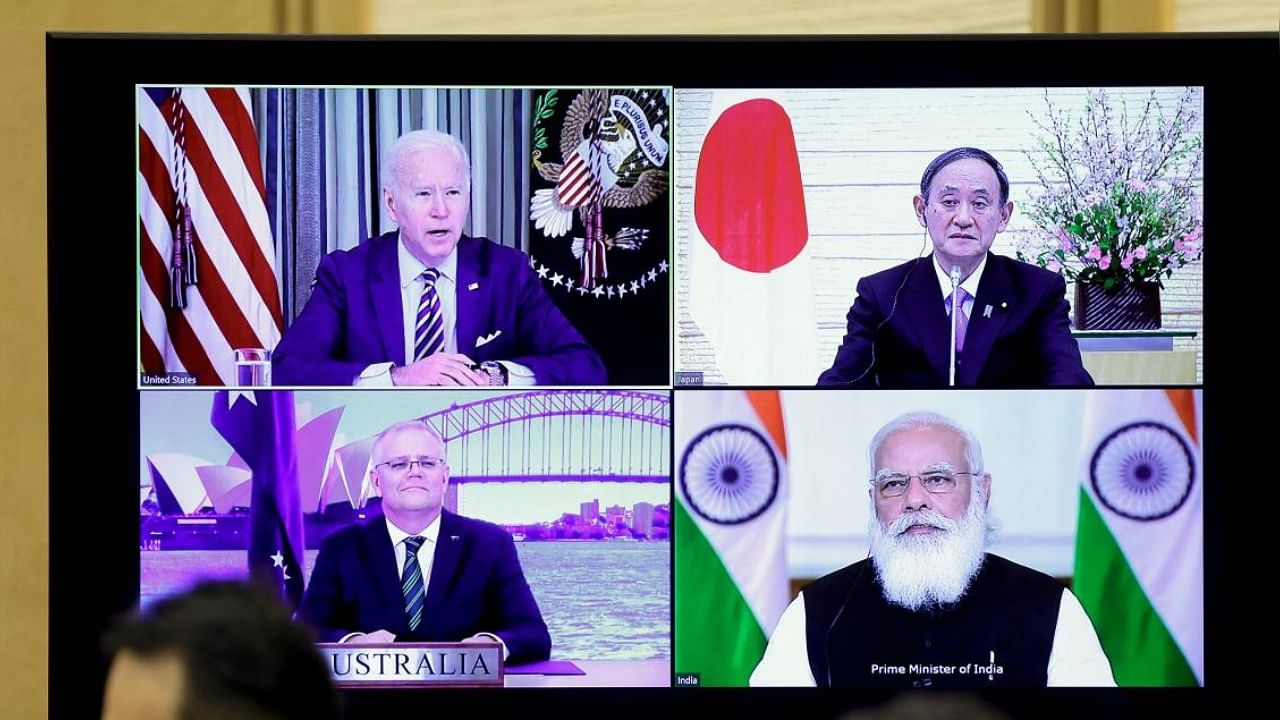
As Prime Minister Narendra Modi lands in the US for his first in-person Quadrilateral (US-India-Japan-Australia) Security Dialogue or, simply the Quad, the sheen has been taken off his first in-person meeting with US President Joe Biden. India is already busy downplaying the importance of the AUKUS (Australia-UK-US) trilateral security deal after it was announced on September 16. Some hard lessons can be drawn from the way the AUKUS was formed.
It was worked out in secrecy and sprung as a surprise virtually on the eve of the first physical meeting of the Quad leaders. Those putting the AUKUS into place would have had no doubt that it would dilute the impact of the Quad summit. This suggests that the US had concluded that neither Japan nor India would take on China when the crunch came, and it saw Australia as more reliable.
India’s posturing as the US’ sidekick has been shredded for now. It is neither seen as capable of countering China nor to be trusted with the latest defence technology. The US mistrust of India is underlined by its consistent refusal to lease or sell its SSN (US Navy hull classification for nuclear subs) submarine. This is the technology that Australia is being supplied.
India, incidentally, already has a nuclear-powered submarine, INS Arihant, with three more in the pipeline. However, they are SSBNs (ballistic missile-firing submarines). India has tended to lease SSNs from Russia as its own indigenously developed SSNs may take years to commission.US nuclear submarines are the most advanced and use weapons-grade nuclear fuel for propulsion and can operate for 33 years without refuelling.
Just as the US has NATO for the western world, one may now be witnessing a similar security arrangement of Anglophone nations for the East. India (and Japan) for now seem destined to remain in the outhouse. Australia is a non-nuclear power under NPT (Nuclear Non-proliferation Treaty) and is entitled to use nuclear technology for civilian uses only. However, it is now being offered the technology to build nuclear-powered submarines using weapons-grade Uranium-235 (enriched to 90 per cent). The Australian submarines will clearly not have a civilian role. The technology was so closely held by the US that it had reportedly refused to discuss sharing it with Australia two years ago in Track-2 dialogues with that country.
While none of this suggests that the Quad will now become redundant, it will certainly lose importance as a strategic counter to China. Notwithstanding its commitments to a free and open Indo-Pacific, friendly maritime exercises, human assistance and disaster relief, joint infrastructure projects, cooperation in critical and emerging technologies, climate change, etc., it will not evolve into anything more. The AUKUS is the new instrument to send a strong message to China. The Quad was once intended to play that role - otherwise, other countries committed to keeping the region free of Chinese dominance, like South Korea, the UK and the EU, would also have been invited into the Quad.
Also read: PM Modi to meet US VP Kamala Harris, hold bilaterals with Japanese, Australian PMs on Sept 23
There is little doubt that the Quad summit on September 24 will come out with a number of statements on areas of common interest, including climate change, but will that be sufficient to show the Indian prime minister’s maiden foreign visit since the pandemic as a grand success? With the undermining of the Quad, success will have to be demonstrated through the upgrading of bilateral relations with the US by strengthening strategic commitment.
Writing in Indian Defence Review, Major General (Retd) SG Vombatkere has explored the possibility of US boots on the ground in India with bases in northwest India being used for staging over-the-horizon operations (https://tinyurl.com/2tdwcnpe). He argues that with Pakistan supporting the Taliban and some West Asian countries friendly to the US being geographically distant, India may become the country of choice for such operations. He suggests that India may not be able to refuse a US request for a military base because it has already signed the logistics support agreement LEMOA (Logistics Exchange Memorandum of Agreement and communications agreement CISMOA (Communication and Information on Security Memorandum of Agreement) with the US.
Although both sides earlier denied such a possibility, Vombatkere bases his speculations on a US Congressional hearing where Secretary of State, Anthony Blinken, gave an evasive reply when this specific question was put to him by a Republican, Mark Green. Blinken responded that he would much “rather take that up in a different setting” and that the US administration was “deeply engaged” with India.
Vombatkere speculates that by allowing US operations from Indian soil, the current government would save face, regain regional hegemony and establish its superiority in strategic partnership with the US. However, the moot question is whether Prime Minister Modi will be willing to take that disastrous plunge – both for Indian security and sovereignty - to make a success of his first bilateral meeting with President Biden?
(The writer is a journalist based in Delhi)
Disclaimer: The views expressed above are the author's own. They do not necessarily reflect the views of DH.
Check out latest videos from DH: